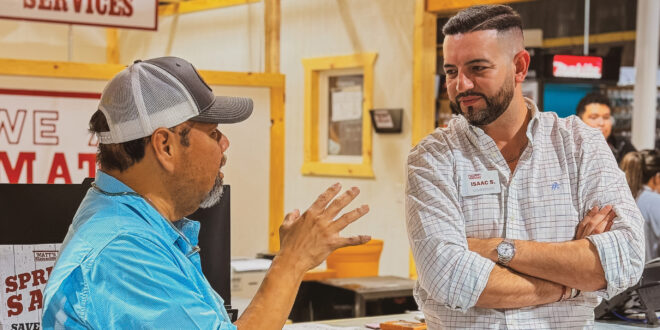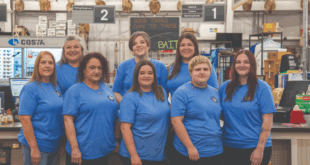They said what?! The game of telephone can produce hilarious results, but in real life, ineffectual communication can cause major issues, whether it’s a relationship with a significant other, among friends or between coworkers.
According to Forbes Advisor’s The State of Workplace Communication in 2024 report, 89% of workers reported that ineffective communication negatively affected them. Of those employees affected, 50% said poor communication impacted job satisfaction, 49% said it affected their productivity and 42% said it increased their stress levels.
The same report found that for over 40% of workers, poor communication reduces trust both in leadership and in their team, making it crucial for independent owners and managers to make communication a priority in their operations.
When an operation is dealing with communication problems, it becomes harder to address difficult situations and have those tough conversations that are guaranteed to occur. As you consider your own communication strategies and evaluate what communication looks like in your operation, two retailers shared with Hardware Retailing the ways they effectively communicate with employees and teach their employees to constructively communicate in the workplace, especially when it comes to challenging situations or difficult conversations.
Tap into these five best practices to improve your operation’s communication and avoid the pitfalls of poor communication.
Be Consistent and Intentional
For Matt’s Building Materials, which has over 200 employees across three locations in Pharr, San Benito and Palmview, Texas, consistency and intentionality are key to effective communication, especially when addressing difficult conversations.
Isaac Smith, who co-owns the operation with his father Danny and brothers Ben and Jeremy, says store managers hold team meetings several times a week. Leadership gets together every Monday morning to address any issues from the previous week and prepare for challenges that might occur in the coming week. The leadership meetings have a loose agenda and are more laid-back so even the most reserved team members have a chance and are comfortable speaking up. Everyone has about five to seven minutes to share to keep the meetings on topic and honor everyone’s time.
“I prefer the beginning of the week for these meetings because we’re closed on Sunday, so we get a chance to reset and relax, and then everybody hits the ground running Monday,” Smith says. “Because so much communication takes place during these meetings, we highly encourage taking notes and have a moderator to keep everyone on track. If there are specific issues or topics anyone needs addressed that we don’t need to discuss in front of the whole team, we table those topics to talk through at a later time.”
Follow-up throughout the week creates consistency. Smith says managers are constantly connecting with one another on any issues or questions that came up in the leadership meetings.
“With these meetings, we try to set the tone for the rest of the week, starting each week consistently with sharing of ideas and solutions,” Smith says. “Issues are more likely to get resolved when we are persistently addressing them each week. Those voids in communication are where problems can creep in. If you don’t have an effective communication plan in place with your team, you’re definitely going to see and feel those difficult moments even more.”
Listen First
While there is no easy answer to communication challenges, Jen Pratt, general manager of Boone Paint & Interiors, focuses on not just hearing—but listening—to her employees, and teaching employees to do the same with one another, especially during conflicts. Pratt manages all three locations of the operation: Boone, Banner Elk and Hickory, North Carolina.
“Listening means your posture is open with no folded or crossed arms. You are quiet and not trying to talk on top of the person or argue,” Pratt says. “I take a step back, keep my mouth closed and listen to the information that is being brought to me. This strategy allows the person who is communicating with you to have their time to explain and not be interrupted. It also allows that person to feel heard and understood, which in most instances calms the interaction.”
After listening to the information that has been communicated to you, Pratt says it is crucial to take a pause to digest it and not immediately react with emotion. After you pause, reiterate and express back the information you have been told to reassure the employee you fully heard what they are trying to convey.
“The pause is important to show that person you really heard what was being brought to you. If it’s a heated debate or an emotional issue, you have that pause to collect cohesive thoughts that are void of inappropriate emotion before responding,” Pratt says. “Oftentimes, people react to comments before digesting them, which results in impulsive reactions or words that can escalate an issue.”
After she pauses to digest what she just heard—which can take minutes, hours or even days—Pratt says she offers a controlled, neutral and firm response.
“A controlled response is one that is non-emotional, not rash and free of favoritism,” she says. “Stay objective, but neutral. When encountering an upset or hostile individual, don’t allow emotion to take over and become combative in return, which will, without a doubt, cause the interaction to go south.”
Pratt worked in law enforcement for over 12 years before joining her father in the family paint business. She was trained to de-escalate situations with difficult or combative individuals, and her experience in retail isn’t that far removed from her time in law enforcement, she says.
“I know from experience in both this line of business and my prior one that people want to be heard and they want to be valued and listened to,” Pratt says. “If you can reserve your natural impulses to respond immediately and really take a step back to acknowledge what you are being told, then you can calm most any situation.”
Coach and Correct
Connected to deliberate listening, Smith says he and other leaders take the approach of coaching while correcting.
Smith uses a platform called Jotform, where he has built a feedback form for managers to use when they need to address an issue with an employee, such as coming into work late or using a cell phone when not permitted. The form includes the name of the employee, an explanation of the issue, any training that took place or needs to occur to rectify the issue and the date and time. Both the manager and the employee sign the form. Having a written record of incidents is also helpful in addressing those situations in the future.
“It only takes about three minutes to fill out, but it allows every manager to be aware that an incident occurred and provides context on how it was addressed through coaching and training,” Smith says. “This tool also allows us to see—in one place—every incident and how each was resolved so similar incidents can be handled in the same way in the future.”
Pratt also approaches communications training with a mindset of coaching. Employees at Boone Paint & Interiors take part in online training to garner knowledge about the products and services they will be providing customers. However, they learn communication skills on the job. Pratt assigns every new employee a manager to shadow and observe how to handle various situations and interactions. Then leadership coaches the employee about the elements of the situation—how it was handled and how it could be handled differently—and get their opinion on what they may have done differently.
“This, in my opinion, is the best way to train a new employee,” Pratt says. “A real world example is going to win over reading an article or listening to someone present this information to you. Nothing will beat personal experience.”
Being able to experience different communications scenarios in real life has been instrumental in all employees improving and building their skills, Pratt says. She realizes that no amount of coaching is perfect, however.
“Above all else, we stress to our employees that when they find themselves in a difficult situation they do not know how to address, then they need to get a manager or myself,” Pratt says.
Stay Positive and Show Grace
Establishing consistent positive communication can take the edge off difficult communications. When communication is overwhelmingly positive, it allows employees to head into tough conversations with a better attitude, which can make all the difference.
Smith says he uses BAND, a free app that facilitates communication among groups, to promote positivity. Everyone in the company has access to Matt’s Building Material’s BAND page, so if an employee makes a great sale or a customer leaves an excellent review, managers can make note of it for all employees to see.
Every manager, team lead and sales team member is required to post at least once a week. Employees can also post something positive or encouraging about a fellow staff member anytime.
“I wanted a place where we could exclusively communicate positivity,” Smith says. “We have company emails, Jotform and WhatsApp for other communications, but I wanted it to be a place where we could promote birthdays, anniversaries and other high points that intentionally encourage and build up.”
Along with positivity, offering understanding is crucial to getting through sticky conversations. Showing grace doesn’t mean excusing every wrongdoing or avoiding difficult communications—these need to be dealt with for an employee to grow—but Smith says leaders can get so wrapped up in what went wrong that they forget each employee is a human being.
“Sometimes the issue at hand isn’t the real issue, and we need to get to the root of the problem,” Smith says. “As an owner, I think it’s important to make sure our employees understand we care about them, we’re empathetic to their needs and will be there for them during the tough times.”
Pratt says Boone Paint & Interiors is a “doors always open” company, and leadership strives for open dialogue.
“We believe in strong communication that goes both ways,” she says. “We value anything our employees have to say and try to be open to changes and create a harmonious work environment.”
Incorporate Into Your Culture
Quality communication needs to be ingrained in the company culture and values. At Matt’s Building Materials, leaders follow “Danny’s Leadership Legacy,” named after owner Danny Smith. The seven core leadership goals included in “Danny’s Leadership Legacy” cover several aspects of communication and motivate leaders to build up and encourage, coach and correct daily and over communicate with one another and their employees.
“From being consistent to coaching and correcting, all of these best practices are wrapped in our core leadership values,” Smith says. “So often, when conflict comes, it’s because we lose sight of those leadership legacy points and our customer service goals. If we stay focused on our mission and values, we do a much better job at communicating effectively. We’re not perfect of course, but by keeping an eye on our goals, we can do our best.”
Dealing With Difficult Customers
While this article focuses mainly on challenges and conflicts among employees, Isaac Smith, co-owner of Matt’s Building Materials, and Jen Pratt, store manager of Boone Paint & Interiors, also share insights on dealing with difficult customers.
At Matt’s Building Materials, all employees are taught and encouraged to understand the three things every customer wants: to be heard, to be understood and to be served. To deliver in these three areas, employees must pay attention, focus and listen carefully, be patient and empathetic and show love, respect, kindness and grace. They are also trained to follow “Matt’s 10 Golden Rules of Customer Service.”
Major tenants of the rules include acknowledging and greeting all customers, treating others the way you want to be treated, putting in 100% effort and over communicating every step.
“If employees follow these to a T, it will solve probably 99% of customer issues,” Smith says. “Even though it’s not rocket science, most of the time we miss the mark, so we consistently talk through the rules and how employees can apply them, not only to work but in their personal lives. I think that speaks volumes that we want our employees to grow at work, but also see growth in their personal lives.”
For employees at Boone Paint & Interiors, Pratt says the employee handbook explicitly advises what the standard operating procedures are for most given situations. Employees read over the handbook and ask any clarifying questions. Training also includes working through different scenarios the employee may encounter and how to handle them.
“We further advise employees that if they end up in a situation that makes them uncomfortable, endangers them or isn’t reaching a resolution that they need to reach out to the manager on duty or upper management to step in,” Pratt says.
 Hardware Retailing The Industry's Source for Insights and Information
Hardware Retailing The Industry's Source for Insights and Information






